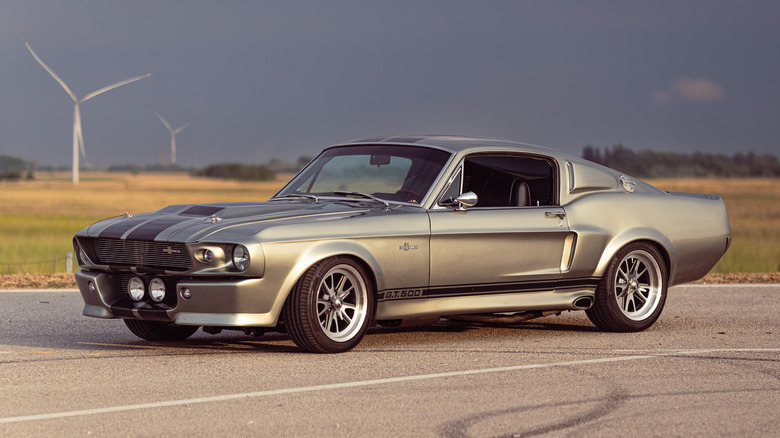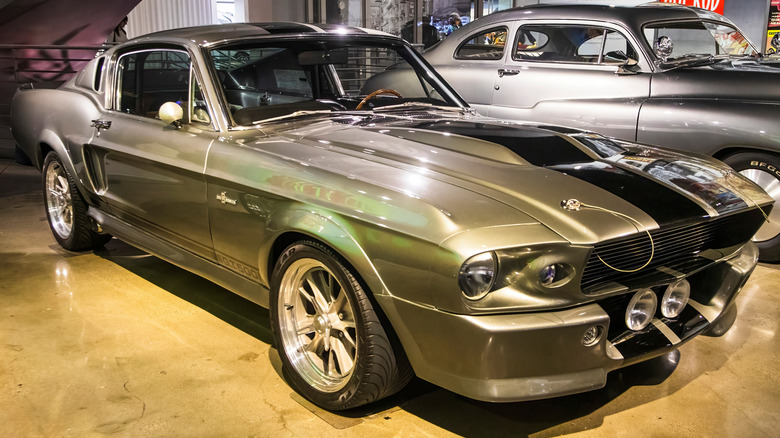Why Is The 1967 Ford Mustang Called Eleanor?
We've witnessed a diverse range of cars gain infamy during the golden age of the car chase scene, from the white Challenger of "Vanishing Point" to the green Mustang of "Bullitt." Arguably, the original 1974 "Gone in 60 Seconds" represents the capstone of this era, featuring the longest single car chase scene ever put to film (40 minutes). The film proved so influential that some 26 years later, the remake starring Nicholas Cage re-introduced the original concept of stealing dozens of vehicles.
While the original film featured 48 stolen cars, capped off with a 1971 Sportsroof Mustang Mach 1 (masquerading as a 1973), the 2000 movie boasted a 1967 Shelby GT500 at the top of a 50-car list. Both of these vehicles were named "Eleanor," which, according to the remake's plotline, was a codename used on the radio frequencies used by the heist crew. Instead of saying they were going to "boost X car," the crew identified every car with a feminine name to keep police guessing as to which car they were referencing.
And so, the mythical Eleanor was born out of necessity for the crew's operation in the movie. Nicholas Cage's character further personifies the car throughout the movie, with the car reacting accordingly (such as stalling out after Cage's character "hurts" Eleanor by damaging the passenger mirror). This level of personification contributed to the car's mystique, providing it with a more tangible, realized character of its own.
What defines Eleanor versus a stock 1967 Shelby GT500
Let's start with the base vehicle: the 1967 Shelby GT500 itself. Originally introduced as a heavily modified Shelby GT350, the GT500 marked the most powerful Mustang to date, utilizing Ford's 428c.i. V8 and rated to 355 horsepower and 420 pound-per-foot of torque. The Shelby lineup garnered an outstanding reputation for speed, especially given the popularity of the 1966 Shelby-Hertz partnership and the GT350-H program. The following year, 1967, Ford introduced the GT500 to the lineup to capitalize on the growing demand for Shelby Mustangs and the explosion in popularity of big-block engines in general.
As for Eleanor, that 1967 GT500 features numerous modifications. The original Shelby GT500 looked quite different than Eleanor, with Eleanor sporting a redesigned front fascia, side-exit exhausts, and a widebody kit. Replica manufacturers produce and sell kits to convert standard Mustangs into Eleanor replicas. Performance-wise, Eleanor sports a 5.8-liter Ford crate engine mated to a 4-speed manual with side-exit exhausts and (in-universe) nitrous injection.
Numerous controversies surrounded the car's starring role in the movie, chief among them being a copyright lawsuit filed by Denise Halicki, the widow of "Gone in 60 Seconds"' producer, for the rights to the Eleanor image. It was argued that the Eleanor Mustangs were copyrightable characters in their own right and could not be legally reproduced. Shelby American opposed to this concept, won the lawsuit, and opened the doors for replica Eleanor vehicles ever since. The ensuing popularity boost helped the 1967 Eleanor Shelby GT500 to cement itself as an icon of car culture, a title it retains today.

